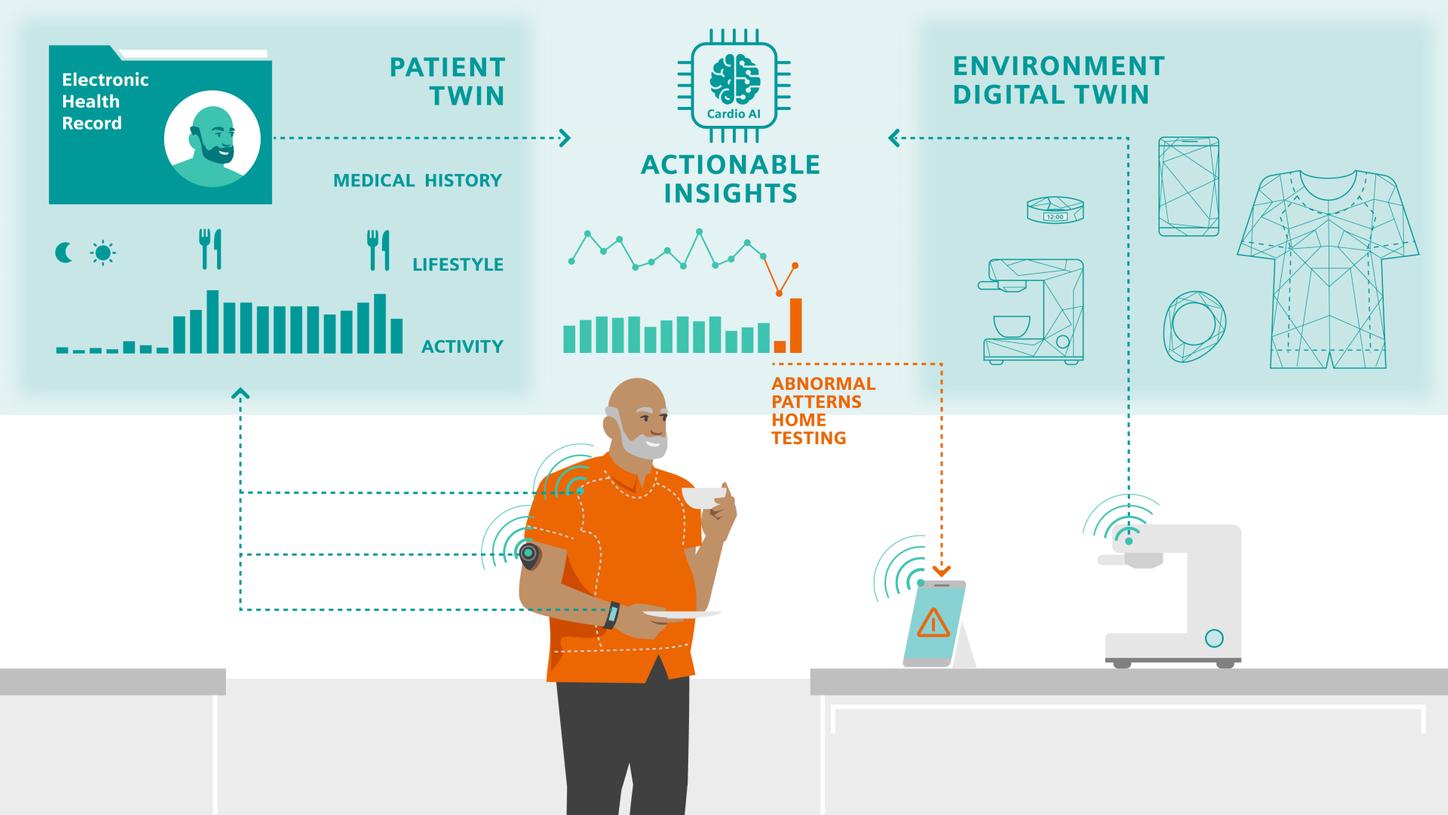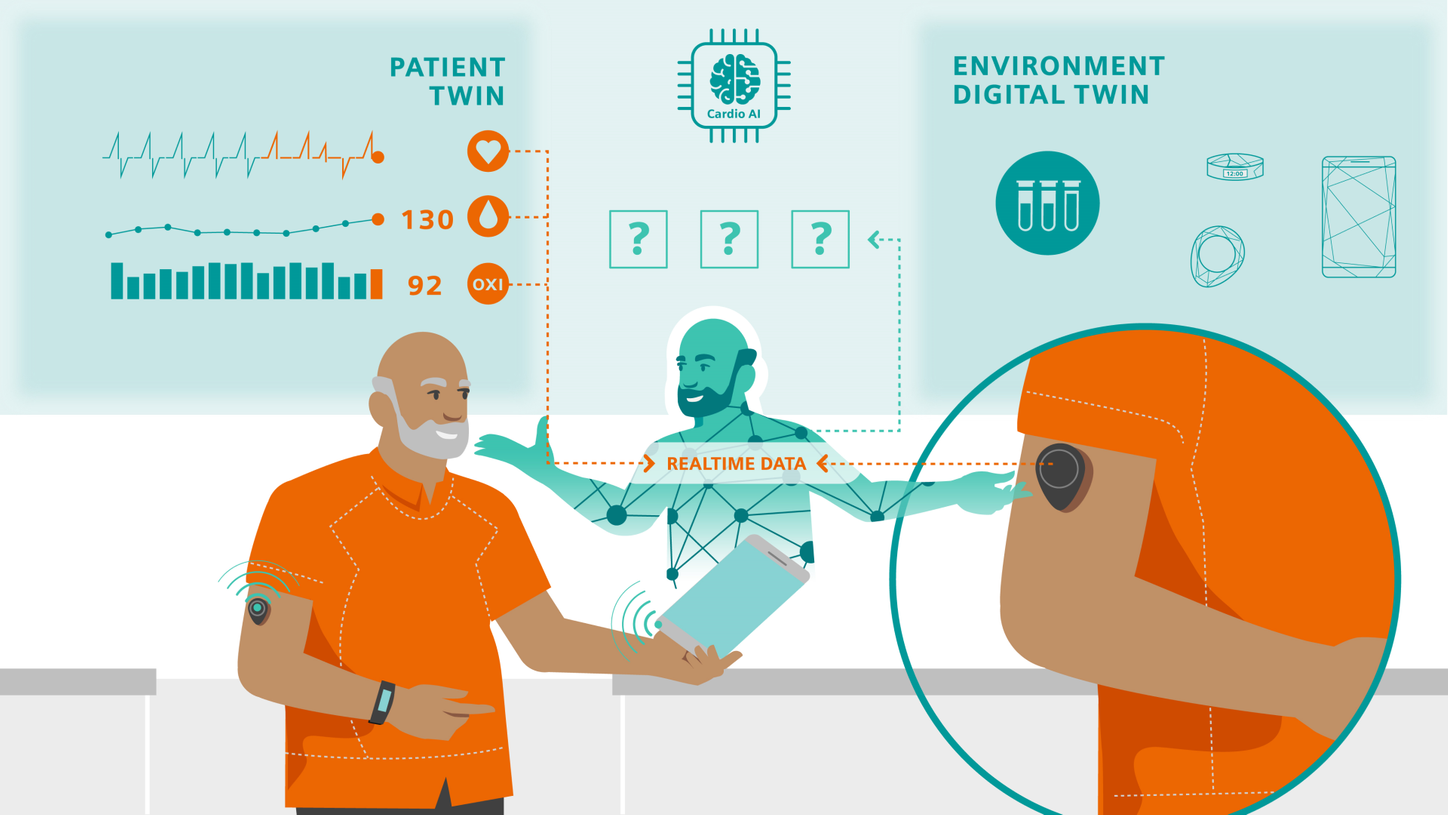Home
Perspectives
- A patient twin to protect John’s heart
A patient twin to protect John’s heart
A patient twin that constantly watches over a person's health? For Siemens Healthineers, this is a vision for the early, targeted detection of heart disease that could become a reality in 10 years. Meet John, a “patient of the future”.
What if we could put patients and medical practitioners in a position to detect the progression of cardiovascular diseases and take appropriate countermeasures to contain them at an early stage? What if we could use digital twin technology to improve the quality of life for those affected and help them to live longer?
- <p>External partners, including cardiologists, radiologists and MTRAs, were involved in developing the future vision alongside experts from Siemens Healthineers, like technical developers, business managers, predevelopers and key experts for future technologies such as artificial intelligence and digital twinning.</p>

What is a patient twin?
The digital health twin of a patient, fed with a wide variety of data. Combining AI, machine learning and data analysis, it mirrors the physical twin and can be used for example to prevent disease.
Source:
https://healthcare-insights.siemens-info.com/en/whats-next/digital-twins.html
All relevant data at a glance
Digital “coach”
A patient twin could become a kind of personal coach for users. Based on increasingly detailed data, this could help users to better understand themselves and adapt their behavior accordingly.
Watch the video: Future technological vision from a clinical perspective
Perfectly networked

Ultrasound at the shopping mall
Get a preventive health check while out shopping?
Heart disease can affect anyone:
- Source: Silent Myocardial Infarction and Long-Term Risk of Heart Failure: The ARIC Study - PubMed (nih.gov)
Source: Emergency Medical Services Response Times in Rural, Suburban, and Urban Areas | Emergency Medicine | JAMA Surgery | JAMA Network
A few weeks later, something unsettling happens
What’s the matter with John?
Cardiac arrhythmia
All changes in electrical heart activity characterized by irregular sequence (arrhythmia), deviation from normal heart rate or disturbance in the temporal course of individual heart actions.
Source:
https://www.pschyrembel.de/
Herzrhythmusst%C3%B6rung/K09QU/doc/
Atrial fibrillations
A temporary or permanent cardiac arrhythmia with subordinate activity of the heart atria resulting in an irregular pulse. Atrial fibrillation increases the risk of stroke and cardiac insufficiency.

Troponin blood test
Digital medical practitioner twin
Digital medical practitioner twin
Intelligent CT imaging

What is FHIR®?
Personalized care
Micro-hospitals
A small inpatient facility with a small number of short-term beds for patients. Micro-hospitals are an emerging trend around the globe. They are capable of providing simple acute and emergency care.
A few years later...
Robot systems today
The CorPath GRX robot system from Corindus is already helping medical practitioners to perform complex interventions in the cardiological and radiological field.

Coronary angiography
An angiography, i.e. a special form of X-ray examination, in which the coronary arteries are mapped. It is performed as part of a cardiac catheter examination.
Source: https://www.pschyrembel.de/
Koronarangiografie/K0C6B/doc/
A vision is gradually becoming reality
The Digital twin of the heart
Watch a presentation about the latest research findings with Professor Thomas Deneke, chief physician at Clinic for Cardiology II at the RHÖN-KLINIKUM Campus Bad Neustadt:
World’s first photon-counting computer tomograph
More information
Share this page
An interdisciplinary team of internal and external experts developed this future vision during workshops led by Dr. Peter Aulbach. An engineer with a doctorate in health sciences, he works in the Technology and Innovation Management (TIM) department.
The future scenario was written up by Katja Gäbelein. She works as a corporate communications editor at Siemens Healthineers, and specializes in technology and innovation topics.
Disclaimer
This text describes possibly future ideas and concepts. It is not intended to describe specific performance and/or safety characteristics of currently planned or future products. Future realization and availability cannot be guaranteed.













